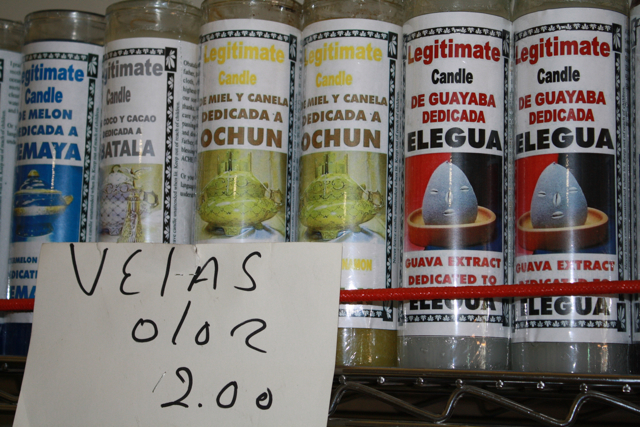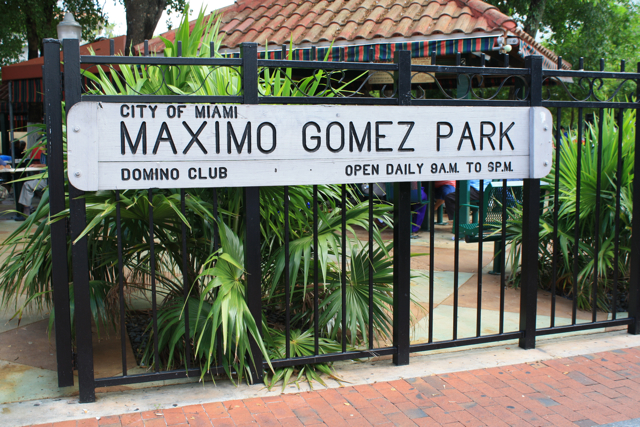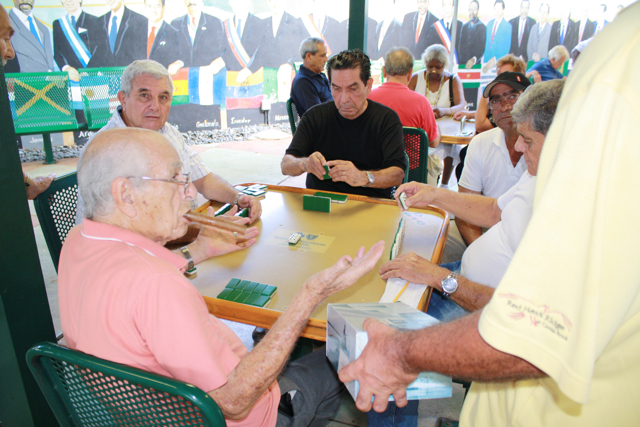From Big to Little Havana
Kelly Knaub

My ten weeks in Cuba finally came to an end and I flew out of Havana two days ago. Since I had a stopover in Miami, I decided to stay for several days before heading home to New York. I traveled to Little Havana yesterday and spent the day exploring the neighborhood and talking to the people.
I met Roberto in the Botanica shop on Calle 8. As I browsed the Orisha cards displayed behind the counter, I struck up a conversation about Cuba. Roberto left the island for Miami in 1993. His parents had already settled here, so he was able to come under a family visa.
Roberto explained that Cuban exiles in Miami are sharply divided, in the same way that people on the island have different opinions about what they want for the country. His family – like that of so many Cubans – is divided. Roberto’s children and other relatives still live in Cuba.

As I walked around the Botanica shop taking pictures of the colorful merchandise, I met a santera named Corinna. She had stopped in the Botanica to buy some things for a friend’s party that evening. Corinna advised me that I shouldn’t be taking photographs of the Orisha merchandise. I assured her that I meant no disrespect.

We then walked to Bordercross, the EcoCultural Center she owns a few doors over, and talked for a bit more. Corinna told me she was inspired to be initiated as a santera after having a prophetic dream. In this dream, Eleggua – a powerful orisha – was pulling her towards him with a garabato (an orisha stick).
She has now been a santera for a year and half. Corinna said the Santeria community in Miami has been hearing that Santeria in Cuba is losing its traditions and some iyabós are being initiated in one week as opposed to the required year. I told her I heard of no such thing in Cuba. I thought back to my experiences with Iyalocha Lourdes in Regla. If anything, it was interesting to see the manifestation of Cuban culture in Miami, on the other side of the looking glass.

I stopped to buy guarapo – sugar cane juice – as I made my way back down Calle 8. It cost $3.00 – compared to the four cents I paid for the sweet drink in Central Havana – and didn’t taste as good. I drank it with nostalgia. I then decided to return to Maximo Gomez Park, the domino club I had visited earlier in the day.

I met Rolando “the pescador,” a Cuban-American born in Long Island, New York, who was eager to share his poetry with me. He recited poems about the liberty of Cuba, the splendor of the United States and a beautiful waitress who once served him. I wandered around the park, taking photographs, and then sat down near a table of men playing dominoes.

The domino club is for senior citizens, and the majority are Cuban men, but I saw several women, and some of the players were from other Latin American countries. A Nicaraguan man, upon hearing that I had just gotten back from Cuba, shouted across the table at me. “Why did you go to Cuba? Cuba is communist! I hate communists!”

“I’m not a communist,” I replied. “Besides,” I continued, “That’s only one aspect of the country.” After the game ended, the man walked over to me and taught me how to play dominoes.
Before I left Little Havana, I met Roberto Ramos, a balsero who arrived to the United States on a small wooden boat in 1992. Roberto told me the story of how he became a passionate Cuban art collector before his journey across the Florida Straits. When he was seventeen years old, an old man in Cuba gave him a painting – El Saxofonista by Carlos Sobrino.

Not knowing who this painter was, he went to various libraries and institutions to do research. He couldn’t find anything. Finally, he discovered that Carlos Sobrino had left Cuba after the revolution and the government had erased his art and history from Cuba’s past. Roberto discovered that art gave him peace and began collecting Cuban paintings. He hid fourteen pieces of artwork – which were later assessed at $680,000 – in the roof of the wooden boat that carried him across the sea for three days.
Roberto verified his story by showing me Great Masters of Cuban Art, a bilingual book published in 2009 that documents his (and his brother’s) art collection and the story behind it. He is now the director of Cubaocho, a cultural art research center across the street from Maximo Gomez Park.
Little Havana was full of colorful stories. I felt the warmth and openness of the Cuban people here in Miami, but I miss the magic of the island. I hope it won’t be too long before I return.






I miss Havana. After leaving Cuba, I began the art of divination (although I had always been able to recognize certain truths all of my life) and everyone, if not corrupt, can divine with some accuracy. Seeing and hearing is something that is quite special, and not all can see and hear. I’ve never been to Miami, so I can’t say if it has the magic of that gorgeous island. Every place on the planet has its similarities and differences. I don’t follow any religion.
Hi — I’m the Corinna mentioned in this blog entry, and I’d like to clarify a few things.
First, what I very clearly stated is that you (Kelly) should not take any picture of ORISHA — actual Orisha. Remember, Kelly, how both Roberto and I explained that you can take pictures of merchandise, like a photo of an Orisha, but an Orisha throne or the actual Orisha is off limits (i.e., that which has been consecrated). Both Roberto and I were specific in explaining what you could or could not photograph in the store. I just thought you should have asked him first before taking so many photos.
Second, I want to clarify that I did not decide to become a Santera because I had a dream. There are many reasons I was called to my faith, and the dream I shared with you was the “clincher” in a series of events and experiences that confirmed to me that this was my path. But to become a Santera one can’t just have a dream and say, “I want to be a Santera.” Divination is what determines whether or not you can become a priest in our religion, or whether or not you can receive any of the initiations (e.g., elekes). I did not take any steps forward without divination.
A note to Michael: You are totally wrong. The year in white is for the first year of initiation as a priest (Babalocha or Iyalocha), when you are a “Iyawo.” It is part of our rite of passage. I did wear all white for a year — last year, when I was a Iyawo. Don’t be so quick to judge what you do not know.
Lastly, a word about the situation in Cuba and here in Miami. I am not here to judge the changes in practices in both Cuba and Miami (and elsewhere). But actually I am far more understanding of changes that are due to extreme poverty and lack of options than of changes that are due to pure greed or lack of respect and devotion.
Certainly, there are many gifted practitioners of Regla de Ocha” or Lukumi (aka Santeria), in both Cuba and Miami, who seek to honor the traditions of their ancestors and the rules of the faith.
Lastly, Kelly, there IS magic here in Little Havana, and if you spent more time here you’d really feel it. The sugarcane juice may be sweeter in Cuba’s Havana, but the cane that provided the juice you recall fondly was cut by men in scorching heat, 12-13 hours a day, for a 7-day work week. It’s easy to romanticize a place when you have money in your pocket and don’t have to worry about finding basic food to eat or being thrown in prison (a year ago, the neighbor of a friend in Havana was sentenced to a year in prison for selling a dozen eggs …)
I love my neighborhood of Little Havana, and I welcome all of you to discover this place.
It’s funny to see the quote from a so-called Santera :”Corinna said the Santeria community in Miami has been hearing that Santeria in Cuba is losing its traditions and some iyabós are being initiated in one week as opposed to the required year.” If that’s a picture of Corinna, she’s already dumped the traditions. She should be wearing ALL white- right down to underwear, shoes and bag and should carry a white umbella. No Habanero would ever mistake her for a Santera.